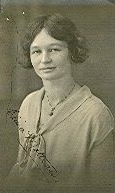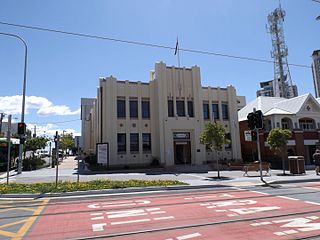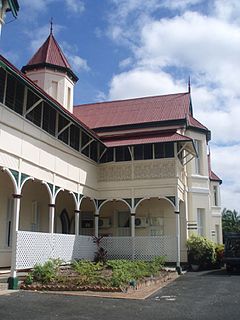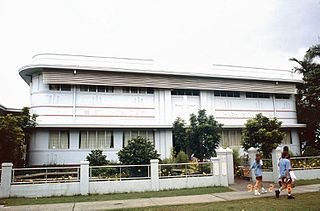
Elina Emily Mottram, (1903–1996) was an England-born architect trained in Brisbane. She was Queensland’s first and longest practicing female architect, practicing and establishing her own business in Brisbane from 1924 to 1975. Mottram died at the age of 93 in 1996.

Monkton is a heritage-listed timber-framed domestic house at 7 Ardoyne Road, Corinda, City of Brisbane, Queensland, Australia. It was designed by Elina Mottram and built in 1925 for William and Margaret Dunlop. It is designed by Elina Emily Mottram, who was the first woman in Queensland to establish her own architectural practice. It is historically significant because of its association with the entry of women into the local professions in Queensland, especially so into the architectural profession. It was added to the Queensland Heritage Register on 31 July 2008.

Southport Town Hall is a heritage-listed former town hall at Nerang Street, Southport, Gold Coast City, Queensland, Australia. It was designed by Hall & Phillips and built in 1935 by H Cheetham. It is also known as Gold Coast City Hall, Gold Coast Town Hall, and South Coast Town Hall. It was added to the Queensland Heritage Register on 5 October 1998.

Chateau Nous is a heritage-listed villa at 1 Rupert Terrace, Ascot, Queensland, Australia. It was designed by Douglas Francis Woodcraft Roberts and built from c. 1937 to 1940s. It was added to the Queensland Heritage Register on 21 October 1992.

Wairuna is a heritage-listed detached house at 27 Hampstead Road, Highgate Hill, City of Brisbane, Queensland, Australia. It was designed by Robin Dods and built from 1896 to 1900. It was added to the Queensland Heritage Register on 21 October 1992.

The Fulton Residence is a heritage-listed detached house at 209 Indooroopilly Road, Taringa, City of Brisbane, Queensland, Australia. It was designed by Charles William Thomas Fulton for his own use and was built in 1940. It was added to the Queensland Heritage Register on 27 October 2000.

Julius Street Flats is a heritage-listed group of seven apartment blocks at 15 Julius Street, New Farm, City of Brisbane, Queensland, Australia. They were built from 1934 to early 1950s. The apartment blocks are called Ardrossan, Green Gables, Julius Lodge, Syncarpia, Ainslie, Pine Lodge and Evelyn Court. They were added to the Queensland Heritage Register on 4 August 1997.

Masel Residence is a heritage-listed detached house at 98 High Street, Stanthorpe, Southern Downs Region, Queensland, Australia. It was designed by Charles William Thomas Fulton and built from 1937 to 1938 by Kell & Rigby. It is also known as Diamond Residence. It was added to the Queensland Heritage Register on 7 February 2005.

Rockhampton Courthouse is a heritage-listed courthouse at 42 East Street, Rockhampton, Rockhampton Region, Queensland, Australia. It was designed by John Hitch and built from 1950 to 1955. It is also known as District Court, Queensland Government Savings Bank, Commonwealth Bank, Magistrate's Court, Police Court, and Supreme Court. It was added to the Queensland Heritage Register on 21 October 1992.

Gladstone Regional Art Gallery and Museum is a heritage-listed former town hall and now art gallery and museum at 144 Goondoon Street, Gladstone, Gladstone Region, Queensland, Australia. It was designed by Roy Chipps and built from 1933 to 1934 by relief workers. It is also known as Gladstone Town Hall & Council Chambers. It was added to the Queensland Heritage Register on 7 July 1998.
Edward Arthur (Eddie) Hegvold was an architect in Rockhampton, Queensland, Australia. A number of his works are now heritage-listed.

Bulletin Building is a heritage-listed printing house at 162-164 Quay Street, Rockhampton, Rockhampton Region, Queensland, Australia. It was designed by Roy Chipps and built in 1926 by R Cousins & Company. It was added to the Queensland Heritage Register on 5 December 2005.

Rockhampton Town Hall is a heritage-listed town hall at 232 Bolsover Street, Rockhampton City, Rockhampton, Rockhampton Region, Queensland, Australia. It was designed by Hockings & Palmer and built from 1939 to 1941 by John Hutchinson of J. Hutchinson & Sons. It is also known as Rockhampton City Hall and Rockhampton Council Chambers. It was added to the Queensland Heritage Register on 29 April 2003.

Rockhampton Girls Grammar School is a heritage-listed private school at 155 Agnes Street, The Range, Rockhampton, Rockhampton Region, Queensland, Australia. It was designed by Edwin Morton Hockings and built in 1890 by Moir Cousins and Co. It was added to the Queensland Heritage Register on 20 October 2000.

Rudd Residence is a heritage-listed villa at 248 Agnes Street, The Range, Rockhampton, Rockhampton Region, Queensland, Australia. It was built from c. 1923. It is also known as Mitchell Residence. It was added to the Queensland Heritage Register on 22 October 1999.

Rockhampton Harbour Board Building is a heritage-listed office building at 288 Quay Street, Rockhampton, Rockhampton Region, Queensland, Australia. It was designed by John William Wilson and built in 1898 by Renshaw & Ricketts. It is also known as Fitzroy Shire Council Chambers. It was added to the Queensland Heritage Register on 21 October 1992.

Rockhampton Base Hospital is an historic hospital at Canning Street, The Range, Rockhampton, Rockhampton Region, Queensland, Australia. It was established in 1867. The hospital's medical superintendent's residence and Therapies Block were added to the Queensland Heritage Register on 21 November 1997.

Ingham Court House is a heritage-listed courthouse at 35-39 Palm Terrace, Ingham, Shire of Hinchinbrook, Queensland, Australia. It was designed by John Hitch of the Department of Public Works (Queensland) and built in 1948. It was added to the Queensland Heritage Register on 28 April 2000.

St Monica's College Sr Cecilia Building is a heritage-listed part of the catholic school in Abbott Street, Cairns City, Cairns, Cairns Region, Queensland, Australia. It was designed by Vibert McKirdy Brown and built in 1941 by VW Doyle. This building was once also known as St Monica's High School and was used for several years as the school administration building, although now it contains classrooms. It was added to the Queensland Heritage Register on 1 July 1997. St Monica’s College is the oldest school in the Cairns region and has two heritage listed buildings - Sr Morrissey Building and the Sr Cecilia Building.

The Second Townsville General Hospital is a heritage-listed former hospital and now an apartment building at 24 Eyre Street, North Ward, Townsville, City of Townsville, Queensland, Australia. It was designed by Donoghue & Fulton and built from 1945 to 1951. It is also known as North Ward Hospital. It was added to the Queensland Heritage Register on 26 April 1996.




















